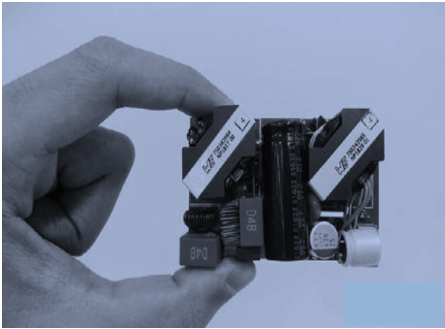Ultra-high power density for 100W USB power delivery adapters.
The USB Power Delivery (PD) standard supports up to 100W of power delivery via USB, which is enough to drive high-power devices such as laptops, monitors and DLP® film projectors.
Active Clamp Flyback (ACF) is a new resonant topology that overcomes these limitations. Unlike QR flyback, ACF enables soft switching and leakage inductance energy recovery. The critical conduction mode ACF uses a small negative magnetizing inductor to achieve zero voltage switching (ZVS) over the entire load range. In addition, the output rectifier implements a zero current switch (ZCS) during turn-off, which reduces the reverse recovery losses of the rectifier and improves EMI performance. With these advantages, high frequency and high efficiency adapters can be realized.
USB PD adapters typically use an inductor-inductor-capacitor (LLC) or quasi-resonant (QR) flyback for isolated DC/DC conversion. The advantage of LLC is that it supports power switches with soft switching, but due to its narrow gain limit, it is not suitable for a wide output voltage range. Moreover, QR flyback operates in discontinuous current conduction mode and does not achieve full soft switching across all output voltage ranges. In addition, the loss of transformer leakage inductance limits the actual maximum switching frequency. When designers want to achieve high power density and small adapter size, the above shortcomings bring great limitations to the implementation of the function.
Circuitry using Texas Instruments' 30 W/in3, 93.4% efficiency, 100 W AC/DC adapterreference design includes UCC28056-based front-end conversion mode power factor correction (PFC) circuitry followed by UCC28780-based isolated DC/DC conversion ACF.
The designer's most important feature is the ultra-high power density of 30 W/in3 without a case. First, the critical conduction mode ACF can achieve a high switching frequency, making the RM8 core available for transformers. Moreover, due to the ultra-high converter efficiency, there is no need to use a heat sink, which saves space and increases power density. Figure 1 shows the AC/DC adapter reference design board.

Figure 1: AC/DC Adapter Reference Design Board
Another important feature of the designer's attention is the high efficiency of the design. The UCC28780 implements the ZVS of the main switch and the ZCS of the secondary rectifier. The secondary resonant configuration forms a primary current waveform that reduces the primary root mean square (RMS) current and significantly improves synchronous rectifier operation. Gallium nitride field effect transistors are used for ACF primary side switches to increase efficiency because they have smaller parasitic parameters. Further efficiency can be achieved by turning off the PFC stage at 5 VOUT and 9 VOUT. Figure 2 shows the average efficiency curve for the reference design.

